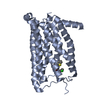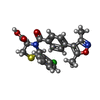+ Open data
Open data
- Basic information
Basic information
| Entry | Database: PDB / ID: 8y6w | ||||||||||||||||||||||||
|---|---|---|---|---|---|---|---|---|---|---|---|---|---|---|---|---|---|---|---|---|---|---|---|---|---|
| Title | TUG-1375 and 4-CMTB-bound human FFA2 in complex with Gi | ||||||||||||||||||||||||
 Components Components |
| ||||||||||||||||||||||||
 Keywords Keywords | MEMBRANE PROTEIN / GPCR | ||||||||||||||||||||||||
| Function / homology |  Function and homology information Function and homology informationpositive regulation of acute inflammatory response to non-antigenic stimulus / regulation of peptide hormone secretion / regulation of acute inflammatory response / leukocyte chemotaxis involved in inflammatory response / mucosal immune response / Free fatty acid receptors / positive regulation of cytokine production involved in immune response / cell surface pattern recognition receptor signaling pathway / lipid storage / cellular response to fatty acid ...positive regulation of acute inflammatory response to non-antigenic stimulus / regulation of peptide hormone secretion / regulation of acute inflammatory response / leukocyte chemotaxis involved in inflammatory response / mucosal immune response / Free fatty acid receptors / positive regulation of cytokine production involved in immune response / cell surface pattern recognition receptor signaling pathway / lipid storage / cellular response to fatty acid / fat cell differentiation / ligand-gated ion channel signaling pathway / adenylate cyclase inhibitor activity / positive regulation of protein localization to cell cortex / T cell migration / Adenylate cyclase inhibitory pathway / positive regulation of chemokine production / D2 dopamine receptor binding / response to prostaglandin E / adenylate cyclase regulator activity / G protein-coupled serotonin receptor binding / adenylate cyclase-inhibiting serotonin receptor signaling pathway / cellular response to forskolin / regulation of mitotic spindle organization / positive regulation of interleukin-8 production / cell projection / Regulation of insulin secretion / positive regulation of cholesterol biosynthetic process / negative regulation of insulin secretion / G protein-coupled receptor binding / G protein-coupled receptor activity / adenylate cyclase-inhibiting G protein-coupled receptor signaling pathway / response to peptide hormone / positive regulation of insulin secretion / adenylate cyclase-modulating G protein-coupled receptor signaling pathway / G-protein beta/gamma-subunit complex binding / centriolar satellite / Olfactory Signaling Pathway / Activation of the phototransduction cascade / G beta:gamma signalling through PLC beta / Presynaptic function of Kainate receptors / Thromboxane signalling through TP receptor / G protein-coupled acetylcholine receptor signaling pathway / G-protein activation / Activation of G protein gated Potassium channels / Inhibition of voltage gated Ca2+ channels via Gbeta/gamma subunits / Prostacyclin signalling through prostacyclin receptor / G beta:gamma signalling through CDC42 / Glucagon signaling in metabolic regulation / G beta:gamma signalling through BTK / Synthesis, secretion, and inactivation of Glucagon-like Peptide-1 (GLP-1) / ADP signalling through P2Y purinoceptor 12 / photoreceptor disc membrane / Sensory perception of sweet, bitter, and umami (glutamate) taste / Glucagon-type ligand receptors / Adrenaline,noradrenaline inhibits insulin secretion / Vasopressin regulates renal water homeostasis via Aquaporins / GDP binding / Glucagon-like Peptide-1 (GLP1) regulates insulin secretion / G alpha (z) signalling events / cellular response to catecholamine stimulus / ADP signalling through P2Y purinoceptor 1 / ADORA2B mediated anti-inflammatory cytokines production / G beta:gamma signalling through PI3Kgamma / Cooperation of PDCL (PhLP1) and TRiC/CCT in G-protein beta folding / adenylate cyclase-activating dopamine receptor signaling pathway / glucose homeostasis / GPER1 signaling / Inactivation, recovery and regulation of the phototransduction cascade / cellular response to prostaglandin E stimulus / G-protein beta-subunit binding / heterotrimeric G-protein complex / G alpha (12/13) signalling events / sensory perception of taste / extracellular vesicle / signaling receptor complex adaptor activity / Thrombin signalling through proteinase activated receptors (PARs) / retina development in camera-type eye / G protein activity / GTPase binding / Ca2+ pathway / midbody / fibroblast proliferation / High laminar flow shear stress activates signaling by PIEZO1 and PECAM1:CDH5:KDR in endothelial cells / cell cortex / G alpha (i) signalling events / G alpha (s) signalling events / phospholipase C-activating G protein-coupled receptor signaling pathway / G alpha (q) signalling events / Hydrolases; Acting on acid anhydrides; Acting on GTP to facilitate cellular and subcellular movement / Ras protein signal transduction / Extra-nuclear estrogen signaling / cell population proliferation / ciliary basal body / G protein-coupled receptor signaling pathway / lysosomal membrane / cell division / GTPase activity / lipid binding / synapse Similarity search - Function | ||||||||||||||||||||||||
| Biological species |  Homo sapiens (human) Homo sapiens (human) | ||||||||||||||||||||||||
| Method | ELECTRON MICROSCOPY / single particle reconstruction / cryo EM / Resolution: 3.19 Å | ||||||||||||||||||||||||
 Authors Authors | Kugawa, M. / Kawakami, K. / Kise, R. / Kobayashi, K. / Kojima, A. / Inoue, W. / Fukuda, M. / Inoue, A. / Kato, H.E. | ||||||||||||||||||||||||
| Funding support |  Japan, 2items Japan, 2items
| ||||||||||||||||||||||||
 Citation Citation |  Journal: Nat Commun / Year: 2025 Journal: Nat Commun / Year: 2025Title: Structural insights into lipid chain-length selectivity and allosteric regulation of FFA2. Authors: Mai Kugawa / Kouki Kawakami / Ryoji Kise / Carl-Mikael Suomivuori / Masaki Tsujimura / Kazuhiro Kobayashi / Asato Kojima / Wakana J Inoue / Masahiro Fukuda / Toshiki E Matsui / Ayami ...Authors: Mai Kugawa / Kouki Kawakami / Ryoji Kise / Carl-Mikael Suomivuori / Masaki Tsujimura / Kazuhiro Kobayashi / Asato Kojima / Wakana J Inoue / Masahiro Fukuda / Toshiki E Matsui / Ayami Fukunaga / Junki Koyanagi / Suhyang Kim / Hisako Ikeda / Keitaro Yamashita / Keisuke Saito / Hiroshi Ishikita / Ron O Dror / Asuka Inoue / Hideaki E Kato /   Abstract: The free fatty acid receptor 2 (FFA2) is a G protein-coupled receptor (GPCR) that selectively recognizes short-chain fatty acids to regulate metabolic and immune functions. As a promising therapeutic ...The free fatty acid receptor 2 (FFA2) is a G protein-coupled receptor (GPCR) that selectively recognizes short-chain fatty acids to regulate metabolic and immune functions. As a promising therapeutic target, FFA2 has been the focus of intensive development of synthetic ligands. However, the mechanisms by which endogenous and synthetic ligands modulate FFA2 activity remain unclear. Here, we present the structures of the human FFA2-Gi complex activated by the synthetic orthosteric agonist TUG-1375 and the positive allosteric modulator/allosteric agonist 4-CMTB, along with the structure of the inactive FFA2 bound to the antagonist GLPG0974. Structural comparisons with FFA1 and mutational studies reveal how FFA2 selects specific fatty acid chain lengths. Moreover, our structures reveal that GLPG0974 functions as an allosteric antagonist by binding adjacent to the orthosteric pocket to block agonist binding, whereas 4-CMTB binds the outer surface of transmembrane helices 6 and 7 to directly activate the receptor. Supported by computational and functional studies, these insights illuminate diverse mechanisms of ligand action, paving the way for precise GPCR-targeted drug design. | ||||||||||||||||||||||||
| History |
|
- Structure visualization
Structure visualization
| Structure viewer | Molecule:  Molmil Molmil Jmol/JSmol Jmol/JSmol |
|---|
- Downloads & links
Downloads & links
- Download
Download
| PDBx/mmCIF format |  8y6w.cif.gz 8y6w.cif.gz | 239.7 KB | Display |  PDBx/mmCIF format PDBx/mmCIF format |
|---|---|---|---|---|
| PDB format |  pdb8y6w.ent.gz pdb8y6w.ent.gz | Display |  PDB format PDB format | |
| PDBx/mmJSON format |  8y6w.json.gz 8y6w.json.gz | Tree view |  PDBx/mmJSON format PDBx/mmJSON format | |
| Others |  Other downloads Other downloads |
-Validation report
| Summary document |  8y6w_validation.pdf.gz 8y6w_validation.pdf.gz | 1.3 MB | Display |  wwPDB validaton report wwPDB validaton report |
|---|---|---|---|---|
| Full document |  8y6w_full_validation.pdf.gz 8y6w_full_validation.pdf.gz | 1.3 MB | Display | |
| Data in XML |  8y6w_validation.xml.gz 8y6w_validation.xml.gz | 42 KB | Display | |
| Data in CIF |  8y6w_validation.cif.gz 8y6w_validation.cif.gz | 64.2 KB | Display | |
| Arichive directory |  https://data.pdbj.org/pub/pdb/validation_reports/y6/8y6w https://data.pdbj.org/pub/pdb/validation_reports/y6/8y6w ftp://data.pdbj.org/pub/pdb/validation_reports/y6/8y6w ftp://data.pdbj.org/pub/pdb/validation_reports/y6/8y6w | HTTPS FTP |
-Related structure data
| Related structure data |  39003MC  8y6yC M: map data used to model this data C: citing same article ( |
|---|---|
| Similar structure data | Similarity search - Function & homology  F&H Search F&H Search |
- Links
Links
- Assembly
Assembly
| Deposited unit | 
|
|---|---|
| 1 |
|
- Components
Components
-Guanine nucleotide-binding protein ... , 3 types, 3 molecules ABC
| #1: Protein | Mass: 40415.031 Da / Num. of mol.: 1 Source method: isolated from a genetically manipulated source Source: (gene. exp.)  Homo sapiens (human) / Gene: GNAI1 / Production host: Homo sapiens (human) / Gene: GNAI1 / Production host:  Trichoplusia ni (cabbage looper) / References: UniProt: P63096 Trichoplusia ni (cabbage looper) / References: UniProt: P63096 |
|---|---|
| #2: Protein | Mass: 39286.891 Da / Num. of mol.: 1 Source method: isolated from a genetically manipulated source Source: (gene. exp.)  Homo sapiens (human) / Gene: GNB1 / Production host: Homo sapiens (human) / Gene: GNB1 / Production host:  Trichoplusia ni (cabbage looper) / References: UniProt: P62873 Trichoplusia ni (cabbage looper) / References: UniProt: P62873 |
| #3: Protein | Mass: 7861.143 Da / Num. of mol.: 1 Source method: isolated from a genetically manipulated source Source: (gene. exp.)  Homo sapiens (human) / Gene: GNG2 / Production host: Homo sapiens (human) / Gene: GNG2 / Production host:  Trichoplusia ni (cabbage looper) / References: UniProt: P59768 Trichoplusia ni (cabbage looper) / References: UniProt: P59768 |
-Antibody / Protein , 2 types, 2 molecules DR
| #4: Antibody | Mass: 27784.896 Da / Num. of mol.: 1 Source method: isolated from a genetically manipulated source Source: (gene. exp.)   Trichoplusia ni (cabbage looper) Trichoplusia ni (cabbage looper) |
|---|---|
| #5: Protein | Mass: 40919.961 Da / Num. of mol.: 1 Source method: isolated from a genetically manipulated source Source: (gene. exp.)  Homo sapiens (human) / Gene: FFAR2, FFA2, GPCR43, GPR43 / Production host: Homo sapiens (human) / Gene: FFAR2, FFA2, GPCR43, GPR43 / Production host:  Homo sapiens (human) / References: UniProt: O15552 Homo sapiens (human) / References: UniProt: O15552 |
-Non-polymers , 2 types, 2 molecules 
| #6: Chemical | ChemComp-9UJ / ( |
|---|---|
| #7: Chemical | ChemComp-A1LYC / ( Mass: 294.800 Da / Num. of mol.: 1 / Source method: obtained synthetically / Formula: C14H15ClN2OS / Feature type: SUBJECT OF INVESTIGATION |
-Details
| Has ligand of interest | Y |
|---|---|
| Has protein modification | Y |
-Experimental details
-Experiment
| Experiment | Method: ELECTRON MICROSCOPY |
|---|---|
| EM experiment | Aggregation state: PARTICLE / 3D reconstruction method: single particle reconstruction |
- Sample preparation
Sample preparation
| Component |
| ||||||||||||||||||||||||||||||||||||||||||
|---|---|---|---|---|---|---|---|---|---|---|---|---|---|---|---|---|---|---|---|---|---|---|---|---|---|---|---|---|---|---|---|---|---|---|---|---|---|---|---|---|---|---|---|
| Molecular weight |
| ||||||||||||||||||||||||||||||||||||||||||
| Source (natural) |
| ||||||||||||||||||||||||||||||||||||||||||
| Source (recombinant) |
| ||||||||||||||||||||||||||||||||||||||||||
| Buffer solution | pH: 7.5 | ||||||||||||||||||||||||||||||||||||||||||
| Specimen | Embedding applied: NO / Shadowing applied: NO / Staining applied: NO / Vitrification applied: YES | ||||||||||||||||||||||||||||||||||||||||||
| Specimen support | Grid material: GOLD / Grid mesh size: 300 divisions/in. / Grid type: Quantifoil R1.2/1.3 | ||||||||||||||||||||||||||||||||||||||||||
| Vitrification | Instrument: FEI VITROBOT MARK IV / Cryogen name: ETHANE / Humidity: 100 % / Chamber temperature: 277 K |
- Electron microscopy imaging
Electron microscopy imaging
| Experimental equipment |  Model: Titan Krios / Image courtesy: FEI Company |
|---|---|
| Microscopy | Model: FEI TITAN KRIOS |
| Electron gun | Electron source:  FIELD EMISSION GUN / Accelerating voltage: 300 kV / Illumination mode: OTHER FIELD EMISSION GUN / Accelerating voltage: 300 kV / Illumination mode: OTHER |
| Electron lens | Mode: BRIGHT FIELD / Nominal defocus max: 1600 nm / Nominal defocus min: 800 nm |
| Specimen holder | Cryogen: NITROGEN |
| Image recording | Electron dose: 45.579 e/Å2 / Film or detector model: GATAN K3 BIOQUANTUM (6k x 4k) |
- Processing
Processing
| CTF correction | Type: PHASE FLIPPING AND AMPLITUDE CORRECTION |
|---|---|
| Symmetry | Point symmetry: C1 (asymmetric) |
| 3D reconstruction | Resolution: 3.19 Å / Resolution method: FSC 0.143 CUT-OFF / Num. of particles: 256705 / Symmetry type: POINT |
| Refinement | Highest resolution: 3.19 Å |
 Movie
Movie Controller
Controller




 PDBj
PDBj






























